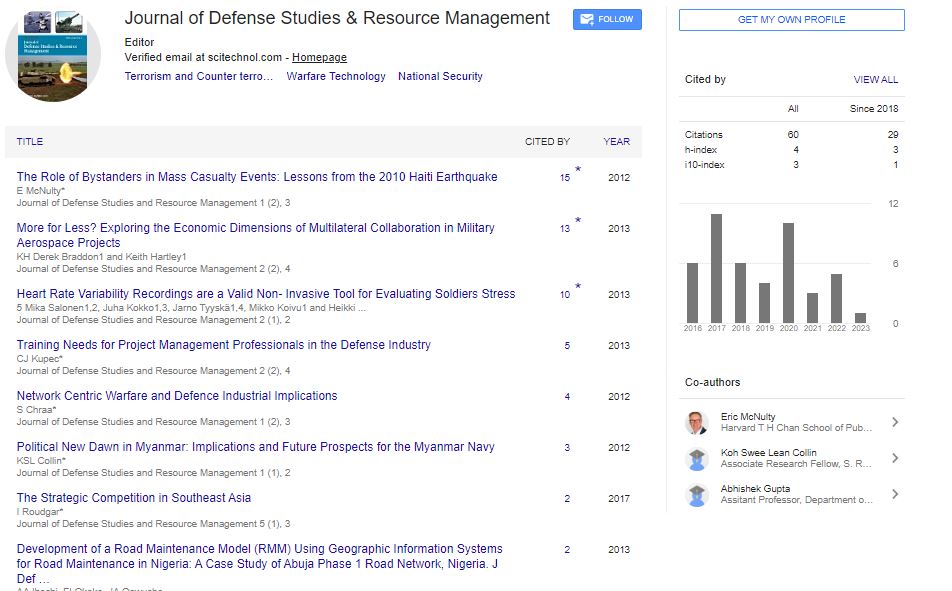Perspective, J Def Stud Resour Manage Vol: 11 Issue: 2
The Impact of Bofors Howitzer in the Kargil Battle
Peter Chamberlin*
1Department of Information Management, Humboldt University of Berlin, Berlin, Germany
*Corresponding Author: Peter Chamberlin,
Department of Information Management,
Humboldt University of Berlin, Berlin, Germany
E-mail: chamberlin@hu-berlin.de
Received date: 29 May, 2023, Manuscript No. JDSRM-23-107158;
Editor assigned date: 31 May, 2023, PreQC No. JDSRM-23-107158(PQ);
Reviewed date: 14 June, 2023, QC No. JDSRM-23-107158;
Revised date: 22 June, 2023, Manuscript No. JDSRM-23-107158(R);
Published date: 29 June, 2023, DOI: 10.4172/2324-9315.1000179
Citation: Chamberlin P (2023) The Impact of Bofors Howitzer in the Kargil Battle. J Def Stud Resour Manage 11:2.
Abstract
Description
The Kargil Battle of 1999 among India and Pakistan displayed the critical pretended by the Bofors howitzer big guns framework in reversing the situation of the contention. The Bofors firearm, a result of Swedish arms producer Bofors Stomach muscle, turned into a distinct advantage for India, showing its viability, exactness, and flexibility on the front line. This article investigates how the Bofors gunnery framework became instrumental in India's prosperity during the Kargil War, featuring its effect on the result of the contention.
Foundation of the Kargil war
The Kargil War emitted in May 1999 when Pakistani soldiers, masked as aggressors, penetrated Indian-controlled positions in the Kargil area of Jammu and Kashmir. The contention saw extraordinary battle activities in rough uneven landscape, presenting huge difficulties for the two sides. India sent off an enormous military reaction to oust the Pakistani gatecrashers and recover control of the involved posts.
The Game-changing bofors howitzer
The Bofors FH77B howitzer, a 155 mm field cannons weapon, arose as a distinct advantage for the Indian Armed force during the Kargil War. The Bofors weapon had been obtained by India in the last part of the 1980s after an extended and disputable procurement process. Regardless of the debates encompassing the arrangement, the Bofors howitzer demonstrated its grit during the conflict. The Bofors howitzer displayed extraordinary exactness, empowering exact focusing of foe positions in the rough precipitous territory. Its long-range capacity permitted Indian mounted guns units to draw in Pakistani gatecrashers from safe distances, limiting the gamble to Indian soldiers. The Bofors weapon showed a noteworthy pace of discharge, with the capacity to quickly convey a high volume of cannons adjusts on track. Its capability assumed a vital part in smothering foe positions and giving compelling cover to Indian ground powers. The Bofors howitzer was profoundly portable, furnished with a self-pushed gunnery carriage, which worked with quick sending and repositioning in the difficult uneven landscape. Its flexibility permitted Indian big guns units to answer rapidly to changing fight situations.
Influence on the kargil war
The Bofors howitzer assumed a critical part in the Kargil War and unequivocally affected the result of key fights. The exact and quick discharge of the Bofors howitzer permitted Indian cannons units to kill Pakistani gunnery positions, obliterating or debilitating adversary firearms that undermined Indian soldiers. This prevalence in big guns capability gave the Indian Armed force a particular benefit on the combat zone. The Bofors howitzer's reach and precision empowered Indian powers to target and annihilate foe places that were hindering invasion courses along the Line of Control. By killing these positions, the Bofors firearm worked with the development of Indian soldiers, empowering them to acquire a competitive edge in the contention.
The staggering effect of Bofors ordnance strikes on Pakistani positions demoralizingly affected the adversary. The precision and capability of the Bofors howitzer made alarm and disturbed Pakistani soldiers, essentially affecting their spirit and capacity to support the battle. The Bofors howitzer gave basic fire backing to Indian ground troops, both in hostile and cautious activities. Its capacity to convey exact and quick ordnance fire assisted with smothering foe positions, make roads for Indian troop developments, and eventually work with the effective recover of key levels in the Kargil area.
Conclusion
The Bofors howitzer arose as a unique advantage for India in the Kargil War, exhibiting its precision, reach, portability, and capability. The staggering effect of the Bofors firearm on foe positions dispirited Pakistani soldiers and supported the certainty of Indian powers. The progress of the Bofors cannons framework in the Kargil War highlighted the significance of current and high level weaponry in present day fighting. It featured the meaning of precise and flexible ordnance frameworks in hilly and testing landscapes. The Bofors howitzer's exhibition in the Kargil War set its standing as a powerful gunnery framework and reaffirmed India's obligation to keeping serious areas of strength for a cutting edge protection stockpile. The illustrations gained from the contention keep on molding India's safeguard methodology and highlight the significant job that best in class cannons frameworks play in contemporary fighting.
 Spanish
Spanish  Chinese
Chinese  Russian
Russian  German
German  French
French  Japanese
Japanese  Portuguese
Portuguese  Hindi
Hindi 